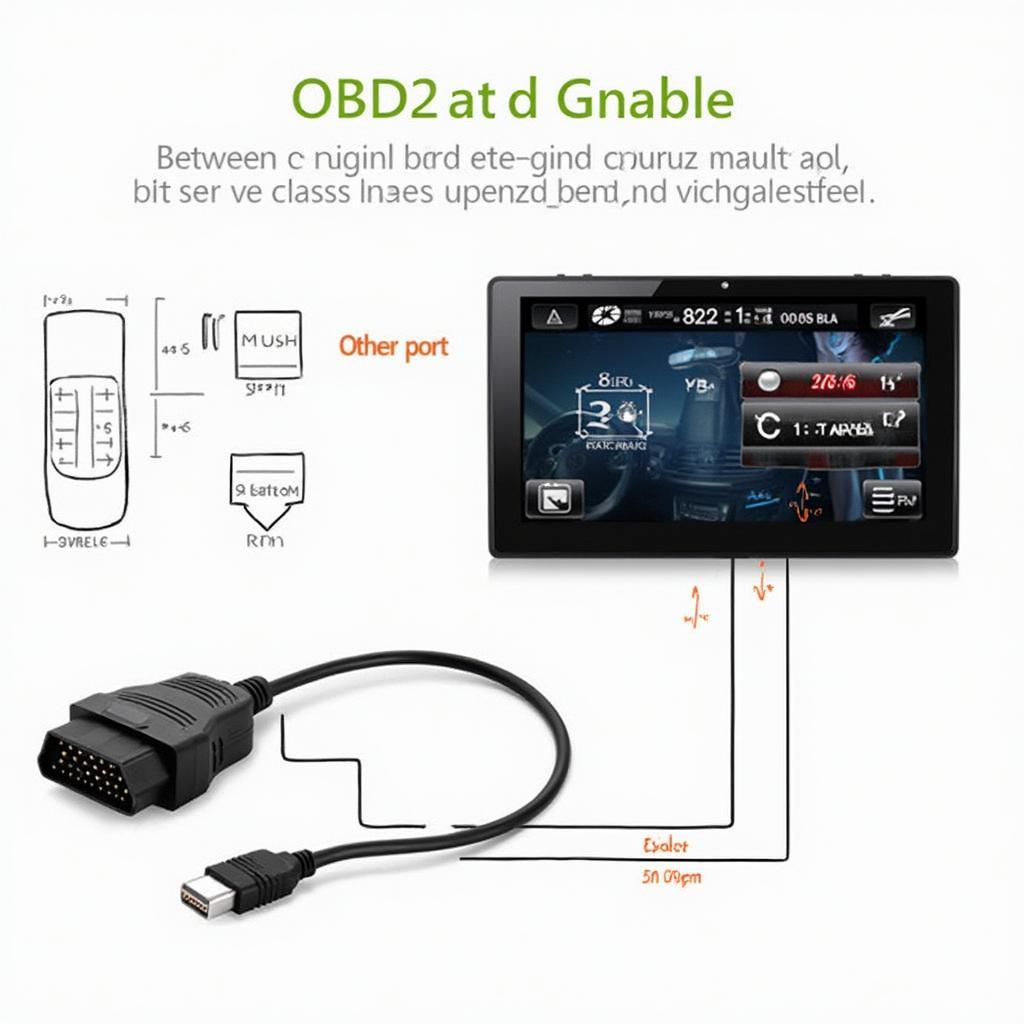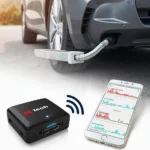Connecting your OBD2 scanner to an in-dash touch screen can transform your driving experience, providing real-time vehicle data and enhanced diagnostics right at your fingertips. This guide explores the various methods and benefits of integrating OBD2 to in-dash touch screen systems.
From understanding the basics of OBD2 technology to choosing the right interface for your car, we’ll cover everything you need to know to make an informed decision. We’ll also delve into the advanced features and functionalities unlocked by this integration, including performance monitoring, custom dashboards, and even code clearing capabilities. After reading this article you’ll understand the many advantages of having a convenient display right on your dashboard. This is much more useful than having to fumble with a small handheld device. Check out our article on the best OBD2 reader for Honda for more information.
Understanding OBD2 and In-Dash Touch Screens
OBD2, or On-Board Diagnostics II, is a standardized system that allows access to a vehicle’s diagnostic data. It’s the port mechanics use to diagnose your car’s problems. An in-dash touch screen, typically part of a modern car’s infotainment system, provides a central interface for controlling various functions, including navigation, entertainment, and increasingly, vehicle diagnostics. Integrating these two systems offers a seamless way to monitor and interact with your car’s performance. You can even customize the display with information relevant to you.
 OBD2 Touch Screen Integration Diagram
OBD2 Touch Screen Integration Diagram
Methods for OBD2 to In-Dash Touch Screen Integration
There are several methods to connect your OBD2 to your in-dash touch screen, each with its own pros and cons.
- Direct Integration: Some high-end vehicles offer built-in OBD2 integration with their touch screens, providing a seamless and factory-installed solution.
- Aftermarket Head Units: Replacing your factory head unit with an aftermarket one that supports OBD2 connectivity is a popular option, offering a wider range of features and customization. Look for models with Android Auto or Apple CarPlay.
- OBD2 Dongles and Apps: Wireless OBD2 dongles paired with dedicated apps on your touch screen can provide a cost-effective way to access diagnostic data. This solution allows for portability.
- Dedicated OBD2 Interfaces: These interfaces connect directly to the OBD2 port and offer a dedicated display for vehicle data, which can often be integrated with the existing touch screen system.
Benefits of OBD2 to In-Dash Touch Screen Integration
Integrating your OBD2 scanner with your in-dash touch screen unlocks a wealth of benefits:
- Real-time Monitoring: Keep a constant eye on crucial vehicle parameters like speed, RPM, coolant temperature, and fuel consumption.
- Enhanced Diagnostics: Quickly identify and diagnose potential issues by viewing diagnostic trouble codes (DTCs) and other sensor data directly on your touch screen.
- Performance Monitoring: Track performance metrics like acceleration, braking, and fuel efficiency to optimize your driving style and identify potential problems.
- Customizable Dashboards: Tailor the display to show the information most relevant to you, creating a personalized driving experience. You might want to track your tire pressure or battery voltage.
- Improved Safety: By monitoring critical systems in real-time, you can identify potential problems before they become safety hazards. For example, you might be alerted to low tire pressure.
Do you have experience with Topdon OBD2 for Subaru vehicles? It might be a great option for integration.
Choosing the Right OBD2 Interface
Selecting the correct interface for your car and touch screen is crucial for seamless integration. Consider the following factors:
- Vehicle Compatibility: Ensure the interface is compatible with your car’s make, model, and year.
- Touch Screen Compatibility: Check if the interface is compatible with your specific in-dash touch screen system, whether it’s a factory-installed unit or an aftermarket one.
- Features and Functionality: Consider the features offered by the interface, such as real-time data monitoring, DTC reading and clearing, and customizability options.
- Wireless Connectivity: Opt for a wireless interface for a cleaner and more convenient setup. This is the most common method for modern cars.
- App Compatibility: If using a dongle, ensure the accompanying app is compatible with your touch screen’s operating system (Android or iOS). You’ll also need to determine if your head unit is compatible with an app.
- Budget: Interfaces range in price from affordable dongles to more expensive dedicated systems. Choose one that fits your budget and needs.
Troubleshooting Common Issues
Sometimes, integrating an OBD2 scanner with an in-dash touch screen can present some challenges. Here’s a look at some common issues and solutions:
- Connection Problems: Ensure the OBD2 connector is properly seated in the port and that the wireless connection (if applicable) is stable.
- App Compatibility Issues: Verify that the app you are using is compatible with both your OBD2 dongle and your in-dash touch screen’s operating system.
- Data Display Problems: Check the settings within the app or interface to ensure the correct parameters are being displayed.
- Inaccurate Readings: If you suspect inaccurate readings, try using a different OBD2 scanner or app to verify the data.
Conclusion
Integrating your OBD2 to your in-dash touch screen empowers you with valuable insights into your vehicle’s performance and health, right at your fingertips. By choosing the right interface and understanding the integration process, you can enhance your driving experience and potentially save money on repairs. By leveraging this technology, you can transform your dashboard into a powerful diagnostic and performance monitoring tool. Thinking of using a Launch scan tool CRP129X OBD2 scanner? Consider connecting to your in-dash touch screen for the ultimate OBD2 experience!
FAQ
- Can I connect any OBD2 scanner to any touch screen? No, compatibility is crucial. Ensure both the scanner and the touch screen are compatible with each other.
- Is professional installation required? For simpler solutions like dongles, no. More complex integrations might require professional help.
- What if my car doesn’t have a touch screen? Consider aftermarket head units that offer touch screen functionality and OBD2 connectivity.
You can also learn how to connect OBD2 to android radio. Or, if you are looking for a Windows-based solution, check out our article on Torque Lite & Pro OBD2 & Car for PC Windows.
For support, contact us via WhatsApp: +1(641)206-8880, Email: [email protected], or visit our office at 789 Elm Street, San Francisco, CA 94102, USA. Our customer support team is available 24/7.
